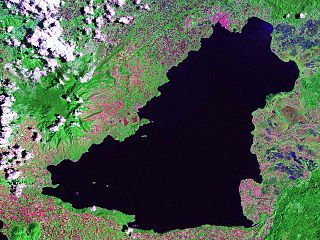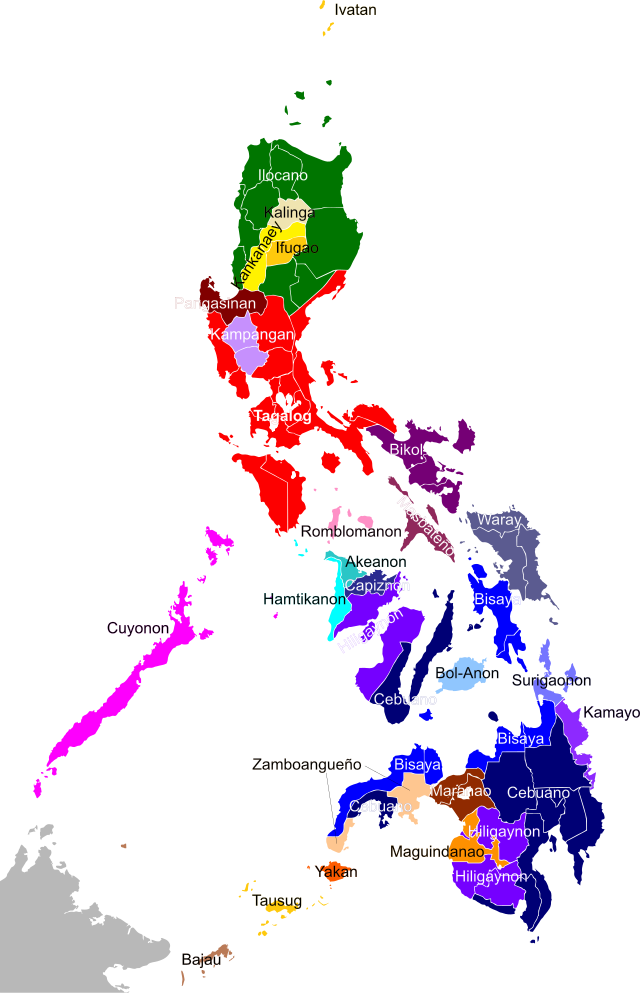Top Qs
Timeline
Chat
Perspective
Maranao people
Austronesian ethnic group of the southern Philippines From Wikipedia, the free encyclopedia
Remove ads
The Maranao people (Maranao: Bangsa Mëranaw; Filipino: mga Maranaw[2]), also spelled Meranaw, Maranaw, and Mëranaw, is a predominantly Muslim Filipino and Austronesian ethnic group native to the region around Lanao Lake in the island of Mindanao. They are known for their artwork, weaving, wood, plastic and metal crafts and epic literature, the Darangen. They are ethnically and culturally closely related to the Iranun people and Maguindanao people, all three groups being denoted speaking Danao languages and giving name to the island of Mindanao. They are grouped with other Moro people due to their shared religion.
This article needs additional citations for verification. (May 2019) |
Remove ads
Etymology
The name "Maranao" (also spelled "Mëranaw", or "Maranaw") means "people of the lake" (lanaw or ranaw, archaic danaw, means "lake" in the Maranao language). This is in reference to Lake Lanao, the predominant geographic feature of the ancestral homeland of the Maranao people.[3]
The original endonym of the ancestral Maranao is believed to be "Iranaoan".[4][5] This group later diverged, resulting in the modern Maguindanaon and the Iranun people (whose names can also be translated to "people of the lake"),[6] while the ancestral Iranaoan who stayed in Lake Lanao became known as the Maranao. These three ethnic groups are still related to each other, share similar cultures and speak languages belonging to the Danao language family.[4][5]
Remove ads
Confederate States of Lanao

The Maranao were the last of the Muslims of the Southern Philippines undergoing Islamization, primarily under the influence of the Arab-Malay missionaries like Sharif Kabungsuan and other from Borneo.
Like neighboring Moros and the Lumads, during the nominal occupation of the Philippines by the Spanish, and later the American and the Japanese, the Maranao had tribal leaders called datu. In the 16th century, upon the arrival of Islam, they developed into kingdoms with sultans due to the influence of Muslim missionaries.
Remove ads
Culture
Summarize
Perspective

Maranao culture can be characterized by:
- Lake Lanao
- Sarimanok (Papanoka a Məra or Marapatik)
- Torogan, Maranao royal houses, where the architecture used is the most aesthetic in the Philippines
- Darangən, an epic UNESCO Intangible cultural heritage
- Kirim, pre-Hispanic handwriting based from Arabic letters with 19 consonants and 7 vowels
- Singkil, a Philippine dance based on a scene from the Darangən[7]
- Okir wood and metal carvings
- Kapmorod and Kakhalilang with Sambolayang and Pasandalan a Morog and Marigay for Kazipa sa Manggis
- Kaplagod (racing horses)
- Tabo, a drum used in mosques to call worshippers to prayer[8]
Maranao culture is centered around Lake Lanao, the largest lake in Mindanao, and second-largest and deepest lake in the Philippines. Lanao is the subject of various myths and legends. It supports a major fishery, and powers the hydroelectric plant installed on it; the Agus River system generates 70% of the electricity used by the people of Mindanao. A commanding view of the lake is offered by Marawi City, the provincial capital.
Visual arts
- Woodcarving of the Sarimanok with okir motifs
- Gadur jar with silver inlay
Sarimanok, Papanok a "Məra" or "Marapatik" is a legendary bird of the Maranao that is a ubiquitous symbol of their art. It is depicted as a Hoodhud (Arabic) with colorful wings and feathered tail, holding a fish on its beak or talons. The head of Sarimanok is like the head of a Hoopoe (Balalatoc in maranaw) and is profusely decorated with scroll, leaf and spiral motifs (okir). It is a symbol of good fortune.[9][10]
The Maranao have also developed their own adaptation of the Ramayana epic, the Maharadia Lawana. They also have a traditional dance, the Singkil, which was based on another local Ramayana adaptation, the Darangən.
Architecture
Traditional Maranao architecture, like elsewhere in the Philippines and at large maritime Southeast Asia, follows the Austronesian framework of wooden structures on piles, divided in three tiers pertaining to social class: torogan of royalty, mala a walay of lesser nobility, and the common lawig analogous to the bahay kubo.
Music and performing arts

Maranao kulintang music is a type of a gong music. Sarunaay is also found among both Muslim and non-Muslim groups of the Southern Philippines. Kobbing is a Maranao instrument and Biyula is another popular Instrument. Biyula is a string instrument. In 2005, the Darangen Epic of the Maranao people of Lake Lanao was selected by UNESCO as a Masterpiece of the Oral and Intangible Heritage of Humanity.
Cuisine
Maranao cuisine is spicier compared to most regions elsewhere in the Philippines, a trait largely shared with much of Mindanao. Traditionally cultivated spices, locally known as palapa (Bontang, native product of Gandamatu) are a common condiment.[11] It is made of stewed sakurab scallion bulbs, ginger, and chillies in coconut oil.[12]
Dishes are intertwined with important cultural rituals across all aspects of Maranao culture: from birth to death.[13]
Social structure
Traditionally, Maranao society is divided into two strata. Namely, mapiyatao (pure) and kasilidan (mixed blood). kasilidan is further subdivided into categories which are as follows; sarowang (non-Maranao), balbal (beast), dagamot (Sorcerer/Sorceress) and bisaya (Slave). The mapiyatao are natives entitled to ascend to thrones by pure royal bloodline. On the other hand, the kasilidan are natives suspected of mixed bloodline. However, due to the changes brought by time, these social strata are beginning to decline due to the improving economic conditions of most Maranao families.
Remove ads
Demographics

Maranaos number 1,800,000 in 2020, representing 1.65% of the population.[14] Along with the Iranun and Maguindanao, the Maranao are one of three, related, indigenous groups native to Mindanao. These groups share genes, linguistic and cultural ties to non-Muslim Lumad groups such as the Tiruray or Subanon. Maranao royals have varied infusions of Arab, Indian, Malay, and Chinese ancestry
Remove ads
Language
Maranao is an Austronesian language spoken by the Maranao people in the provinces of Lanao del Norte and Lanao del Sur.[15] Because of the mass influx of Cebuano migrants to Mindanao, many Maranaos are also fluent in Cebuano. Tagalog is also spoken by the Maranaos, which ranks second among its native language, along with English, and Arabic due to its importance to Islam and Maranao culture.
Remove ads
Notable Maranaos
- Abdullah Maute, a jihadist and co-founder of Maute Group and a brother of Omar Maute.
- Omar Maute, a jihadist and co-founder of Maute Group and a brother of Abdullah Maute.
- Saidamen Pangarungan, a lawyer, businessman, and former chairman of COMELEC and National Commission on Muslim Filipinos.
- Sultan Topaan Disomimba, is a traditional leader, the chairman of the 16 Royal Houses of Lanao and a long time Mayor in the town of Tamparan, Lanao del Sur.
- Datu Benasing "Jun" Macarambon, Jr., former Congressman of Lanao del Sur, 2nd District. He successfully served three terms. During the Duterte Administration, he was appointed as a Board of Director at the Subic Bay Metropolitan Authority. Currently, he serves as a political consultant to successful leaders of Lanao del Sur and even across Lanao del Norte and the NCR.
- Bae Lindao Macarambon-Boransing, the first M'ranao lady lawyer, and the younger sister of Former Congressman Benasing "Jun" Macarambon, Jr.
- Bea Ditma Onayan Macarambon, the first educated M'ranao woman, and the mother of Former Congressman Jun Macarambon and Atty. Lindao Macarambon-Boransing.
- Datu Manaros Boransing, the first M'ranao Certified Public Accountant. He is married to Atty. Lindao Macarambon, and they have 5 children.
- Bae Potre Aguam Macarambon, the first M'ranao lady CPA. She is married to the late Atty. Dagoroan Macarambon, the elder brother of Former Congressman Jun Macarambon.
- Japar Dimaampao is a present Associate Justice of the Supreme Court of the Philippines
- Mamintal A.J. Tamano was a Filipino statesman and a former Senator of the Philippines.
- Adel Tamano is a Filipino educator, lawyer and former politician.
- Domocao Alonto is a former Filipino politician and senator of the Philippines. In 1988, he was awarded the prestigious King Faisal Prize for Service to Islam.
- Mamintal M. Adiong Sr. was a long-time Filipino politician, serving as Governor of Lanao del Sur from 2001 until his death in 2004.
- Mamintal Alonto Adiong Jr. is the present governor of the Province of Lanao del Sur.
- Abul Khayr Alonto is a Filipino businessman and lawyer and a former Moro freedom fighter. He once became the chairman of the Moro National Liberation Front.
- Dimasangcay Pundato is a former Moro revolutionary leader and current undersecretary of the Office of the Presidential Adviser on the Peace Process. He served as the Secretary of the now defunct Office on Muslim affairs (NCMF) for 2 straight administrations.
- Samira Gutoc-Tomawis is a Filipino civic leader, journalist, environment and women's rights advocate, and legislator[1] who has served as member of the Regional Legislative Assembly of the Autonomous Region in Muslim Mindanao and a member of the Bangsamoro Transition Commission which was tasked to draft the Bangsamoro Basic Law.
Remove ads
See also
Notes and references
External links
Wikiwand - on
Seamless Wikipedia browsing. On steroids.
Remove ads



